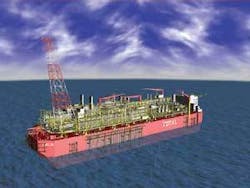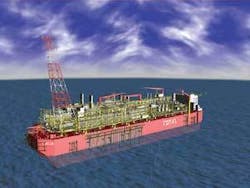Optimization software streamlines FPSO design and construction
Justin Roux, Aveva Group
Current and future global demand for new FPSOs and floating platforms has been estimated at over 100 units. Teamwork will be critical to ensure timely delivery of these complex structures.
There is growing acceptance of the need for more effective collaboration, particularly on projects involving multiple design and construction teams. Beyond improving communication, this means instilling a collective purpose and a combined understanding of a project’s requirements.
In the design and production of a platform hull and topsides, use of a single design model and sharing of information can achieve monumental increases in efficiency. This in turn raises the prospect of not only eliminating schedule overruns, but potentially also bringing forward the start of production.
Last year’s merger of marine engineering software groups Aveva and Tribon may have a key role to play in this process. Aveva’s Plant Design Management System (PDMS) had been widely applied by many of the leading constructors for offshore and marine outfitting design. Tribon’s tools for hull fabrication were used by most of the world’s largest shipbuilders.
By combining these products and services, Aveva is aiming to assist project teams to tighten integration of the design and construction processes of the hull and topsides, from initial design to computer numerically controlled (CNC) robotic production control, by establishing a combined project model. This in turn should enable delivery of stronger and more accurate information, bringing with it a raft of potential benefits:
• Standardization saves a great deal of time and money; there are fewer suppliers to work with or purchase from, and therefore far fewer interoperability issues to resolve. Transfer of data between different design systems always involves extra work, manual intervention, or other time-consuming operations.
• Since all contractors share the same data in real time, greater collaboration is possible. The virtual model of the vessel brings benefit to the manufacturing process, as parts fit the first time, information is available at the earliest possible juncture, and therefore rework cost and time are reduced substantially. Potentially, the savings benefits are up to 10% on production and up to 30% on design.
• The vessel operator gains access to reliable information, both in the run-up to and during the handover from the constructor. This means the operator can follow the project’s progress in greater detail from the outset, in turn allowing earlier and improved training of staff.
Prior to the merger, the two companies’ technologies had been used in conjunction on Total’sDalia FPSO project in Angolan deepwater block 17. At 300 m long, this is one of the world’s largest FPSOs, capable of processing 8 MMcm/d of natural gas and 240,000 b/d of oil, with a storage capacity of 2 MMbbl.
Dalia’s construction is spread between three main venues. Technip in Paris administered the project and managed piping specifications. Topsides design was handled out of Abu Dhabi, with models sent from there to the topsides/hull fabricator Daewoo in South Korea. The hull was built with the assistance of Tribon software.
Operations at the three main offices were synchronized via Aveva’s PDMS Global system, with PDMS Clean Management relaying clean information to the Daewoo team with “no surprises”. However, as information on the hull and topsides were kept separate (this project pre-dating the Aveva/Tribon merger), essential data on topsides/hull interaction had to be assimilated manually.
Aveva’s newest product, Vantage Marine, will allow hull and topsides designers and fabricators to share the same information model tools in the future. Similar FPSO projects of this scope should therefore benefit from further efficiencies, easing the handover of data during and at the close of the project.
Lennart Olsen, former president of Tribon Solutions and now a director of Aveva, says, “Engineers should be able to trust the IT industry to help them build their businesses and infrastructure the way they want to, and we should be able to deliver that assurance without forcing them to retrain their staff and abandon or migrate their valuable data.”
He illustrates his point by citing Tribon’s former software development path. The total cost of the design office is generally much less than arising from assembly, so Tribon’s efforts were allocated accordingly. Version M2 offered a total project savings of 1% through cutting design man-hours, and over 4% of total project savings in assembly. But why try to halve the time spent on a task that represents only a few per cent of the total project?
By focussing on shipyard overheads and materials, the subsequent M3 release offered an estimated 15% savings on the total cost of production. So with two releases, Tribon had effectively given yards producing four ships a year the capability to up that number to five.
Most significant of all, however, is the change in attitude and work process that more integrated technology can deliver. Projects are divided by boundaries between disciplines, offices, phases, and subcontractors. These boundaries are necessary because they define the management of the project and allow it to be planned and run discretely. Integration of information and tasks allows the project to cross those boundaries safely and with versatility.
Traditionally, the term handover has conveyed a single period during which the results of one completed set of actions started the next set. However, in the course of a project, decisions are taken which can be enacted without waiting for unrelated areas of the project to “catch up”.
Through eliminating the sequential approach, and introducing more overlap, there is less of an immediate handover moment, and more of a merging of the project’s various phases - in turn alleviating the specter of all projects, the bottleneck. If properly managed, a “staggered” handover can save up to 19 weeks in bringing a facility online. At the current oil price, that translates into a savings of $15,000/day for a 250,000 b/d facility.

